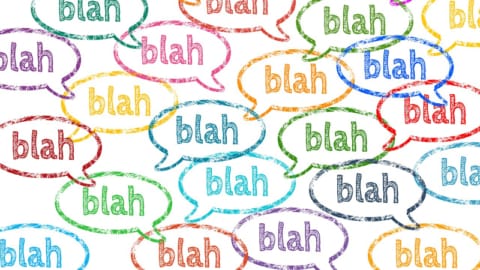Listening is one of the hardest skills for language learners. We often hear “Too fast, teacher,” or “I knew the words but not the meaning.” The problem isn’t just speed or accent – listening breaks down for a range of predictable reasons.
Here are nine of the most common barriers, from vocabulary and rhythm to the messy realities of false starts and fillers, and some practical ways to help, grounded in classroom reality.
1. Lexical coverage & formulaic language (chunks)
Why it matters
Learners don’t just need to know individual words – they need to recognise multi-word chunks like at the end of the day, you know what I mean, or to be honest with you. These phrases carry meaning and help listeners follow the flow of a conversation. If learners only know isolated words, they often say “I knew every word but I didn’t understand the sentence.”
Classroom reality
Imagine playing a 90-second conversation for your class. A few stronger students might catch the gist, but others get lost. It isn’t just the speed – it’s that phrases like “kind of went off the rails” or “to be honest with you” whizz past unrecognised. Without those anchor points, the whole exchange feels confusing.
What you can do
- Before listening: Pre-teach 4–6 common chunks from the dialogue. Write them on the board, but don’t explain in detail yet – just give a quick example sentence: “He was late again, and to be honest with you, I wasn’t surprised.”
- During listening: Ask students simply to raise a hand or jot a tick when they hear one of the phrases. This gives them a clear, achievable goal.
- After listening: Put learners in pairs to match the chunks to meanings, or use them in quick-fire role-plays that recycle the phrases (“Use one chunk to complain about school; use another to give an opinion about food”).
- Then continue with your planned listening tasks: You’ve essentially done an extended pre-teach of key vocabulary (the chunks), removing one barrier, before moving on to your original aims with the text. Over time, this helps learners start to notice such phrases on their own – which is exactly what we want.
2. Connected speech & weak forms
Why it matters
Learners are often taught careful “dictionary pronunciation,” but real speech is full of linking, reductions, and weak forms (going to → gonna; handbag → hambag; of → əv). If learners can’t connect these sounds to the words they know, they assume they’ve never learned them.
Classroom reality
You play “I should’ve told you” and students only hear “I shuda…”. They know should and have, but don’t recognise them in reduced form.
What you can do
- Before listening: Highlight two or three reduced forms or elements of connected speech in the text (gonna, should’ve).
- During listening: Learners circle or whisper those forms each time they hear them in the recording. This gives them a specific listening focus.
- After listening: Back-chain the phrase (told you → should’ve told you → I should’ve told you). Then move into a quick-fire speaking task where that phrase might come up naturally (“Tell your partner about homework you forgot to do – you’ll need a sentence with ‘should’ve’.”). You’re giving students the opportunity to connect the sound with the meaning and immediately recycle it in speech.
- Continue with your planned listening tasks: Again, you’re removing one barrier to comprehension (the reduced forms and connected speech) before moving on to your original aims.
3. Speech rate & pausing
Why it matters
It’s not only speed that confuses learners. English speakers don’t always pause where learners expect. If learners can’t hear the natural “punctuation” of speech, everything blurs together.
Classroom reality
Students say the recording is “too fast,” but slowing it down doesn’t solve much. What they often need is help identifying where one idea ends and the next begins.
What you can do
- Before listening: Show learners a transcript. Ask them to mark where they think the pauses will fall.
- During listening: Play the audio and let them check. They compare what they expected with the reality.
- After listening: Get them to retell the story or conversation in pairs, trying to pause in the same places.
This trains learners to listen for meaning groups, not just words, and makes authentic speech feel less overwhelming. This is more of a complete listening task in itself – showing them the transcript makes additional listening work with the same text less effective.
4. Accent variety
Why it matters
Learners often learn with one “standard” model, then freeze when they hear another. But English is global: the same sentence sounds different in Liverpool, Lagos, and Los Angeles.
Classroom reality
A class that follows a London newsreader with ease may suddenly struggle with an American sitcom, or with a recording of a Spanish or Indian English speaker. It’s not harder – just different.
What you can do
- In class: With the help of a colleague or AI, prepare a second recording of a text you want to use in a different accent. First, run your planned listening stages as normal – for example, gist listening followed by listening for detailed information. Before giving feedback on the detailed information task, play the alternative-accent version of the text. Learners answer the same questions, so the task remains identical but the accent changes. Finally, give out the transcript and replay short sections from both versions. Ask students to highlight which sounds or words were different and which stayed the same. Keep this light and focused on awareness, not phonetic terminology.
- Extension / outside class: Encourage learners to bring in short clips they’ve listened to on YouTube, TikTok, or podcasts in different accents, and share one feature they noticed with the class.
This develops flexibility and confidence, without overwhelming learners with technical phonetics.
5. Background knowledge (schema)
Why it matters
Listening isn’t just decoding, it’s predicting, using what we call top-down processing – activating our existing knowledge of a topic to aid understanding. If learners don’t have this background knowledge, they waste energy trying to fill in the gaps.
Classroom reality
Students listen to a podcast about Thanksgiving dinner. They understand words like turkey, cranberries, and family, but because they don’t know the cultural traditions behind the holiday, they can’t make sense of why people travel, what’s being celebrated, or why certain foods are important.
Or, learners hear two friends chatting about “Strictly.” They know the vocabulary in the exchange, but without recognising that it refers to the UK TV show Strictly Come Dancing, they miss the meaning and humour of the conversation.
What you can do
- Before listening: This stage is about setting learners up with just enough background knowledge. If the text is about Thanksgiving, show a picture of a family meal and ask: What’s the occasion? Who’s at the table? What food do you expect? If it’s about “Strictly,” show the TV logo or a short still image and ask: What kind of programme do you think this is? What might people say about it? Then have a quick discussion to fill in the gaps in background knowledge.
- You can also give an “anticipation grid” of 6–8 words or ideas for learners to predict from. For a Thanksgiving text, the grid might include turkey, family, holiday, parade. For a conversation about “Strictly,” it could be dance, judges, scores, Saturday, audience. Learners tick the ones they expect to hear before listening, then tick the ones they actually hear while listening.
6. Cognitive load & working memory
Why it matters
Listening tasks sometimes demand too much at once. Learners can either decode or remember – not both. If a task asks them to hold too many details in mind, especially when other barriers we’ve discussed are also present, comprehension quickly collapses.
Classroom reality
Students listen to a three-minute news report and then face ten long multiple-choice questions with options that are full sentences. They quickly get lost, not because they don’t understand the text, but because holding the long questions and choices in memory overloads them. When you switch to three short true/false or wh- questions on the same text, their answers improve dramatically. The difficulty came from the task design, not the listening itself.
What you can do
- Before listening: Keep in mind the need for background knowledge, pre-teach vocabulary and give learners a clear gist question, such as What’s the main problem in the report?
- During listening: When moving to detailed information, avoid overloading students with a long list of complex questions. Instead, ask just a few shorter, focused ones. They don’t have to be easier – just fewer and more direct.
- After listening: Build up gradually. Once learners are confident with shorter tasks, extend the length or number of questions in later lessons to develop stamina.
By layering tasks and controlling the load, learners stay engaged and gradually build the capacity to handle more demanding listening activities.
7. Language rhythm and sentence stress
Why it matters
English is a stress-timed language: stressed syllables come at regular intervals, and unstressed ones shrink. Learners from syllable-timed languages (like Spanish or French) often can’t hear these patterns, making speech sound blurred.
Classroom reality
Students follow your careful speech, but in natural conversation unstressed words disappear. They complain “It’s like words are missing.”
What you can do
- Before listening: Model a line with clear sentence stress (I WENT to the SHOP to BUY some MILK). Learners tap or clap the stressed words.
- During listening: Play the audio and ask them to mark the stressed syllables they hear.
- After listening: In pairs, they retell the conversation, trying to keep the same rhythm, even if not word-for-word.
This builds awareness of rhythm and sentence stress in a natural way.
8. False starts & repairs
Why it matters
English is rarely spoken in neat, textbook sentences. In natural conversation, speakers often begin a sentence, stop, and start again – or change direction halfway through. We call these false starts and repairs. To learners, this can sound confusing, as the first attempt at the sentence doesn’t match what follows.
Classroom reality
In a casual dialogue, one speaker says: “So I was going to, well, actually, what happened was, I missed the bus.” Learners follow the first attempt and wait for it to finish, but by the time the sentence has been rephrased, they’ve lost the thread. They end up focusing on the abandoned sentence instead of the final meaning.
What you can do
- Before listening: Prepare learners by explaining that in real conversation, people often restart or change their minds mid-sentence. Give one short example and show that the final version carries the meaning.
- During listening: Play an unscripted clip with several clear false starts (you can easily record some of these or use AI). Ask learners to identify the number of false starts they hear. Listen again, asking them to identify the final meaning. Then give them the transcript, and highlight the false starts and final meaning together.
9. Discourse markers & fillers
Why it matters
Spontaneous speech is full of discourse markers (so, anyway, actually) and fillers (you know, like, well, I mean). These don’t usually add much meaning, but they help speakers manage the conversation. For learners, though, they can be distracting: some try to interpret every filler literally, while others ignore them and miss the signals they give about attitude or topic changes.
Classroom reality
Students listen to two friends talking. One says: “Well, you know, actually, I was kind of thinking we could…” Learners try to translate each word, get bogged down in the fillers, and miss the point – that the speaker is simply suggesting an idea.
What you can do
- Before listening: Briefly introduce a few common fillers and discourse markers. Explain that they often show hesitation, attitude, or a change of direction rather than new information.
- During listening: Play a short clip and ask learners to count how many times fillers or markers occur. This shifts focus from decoding them to simply noticing their presence. Then give learners the transcript, highlight the fillers, and ask: Which words carried the real meaning? Then re-listen with the fillers muted or covered to show how the core message stands out.
- Extension: Encourage learners to use one or two common fillers in role-plays so they experience how natural they sound in conversation.
Helping Learners Move Forward
Listening problems aren’t just about “not listening carefully.” They come from predictable areas: chunks, connected speech, accents, rhythm, background knowledge, memory load, and – in real conversation – the interruptions of false starts and fillers.
We can’t “fix” listening in one lesson. But by weaving small, focused activities like these into a lesson, we give learners tools they can carry into real-world listening. Over time, the complaints of “too fast, teacher” start to fade, replaced with confidence and clearer understanding.
Sources & References
In addition to my own classroom experience, some ideas in this article draw on the following key works in ELT and applied linguistics:
- Field, J. (2009). Listening in the Language Classroom. Cambridge University Press.
- Krashen, S. (1985). The Input Hypothesis: Issues and Implications. Longman.
- Rost, M. (2011). Teaching and Researching Listening. Pearson.
- Thornbury, S. (2002). How to Teach Vocabulary. Pearson Longman.
- Vandergrift, L. & Goh, C. C. M. (2011). Teaching and Learning Second Language Listening: Metacognition in Action. Routledge.










2 comments
Phil
I agree that it is sometimes frustrating even frightening for students to be faced with video or music which contain unfamiliar vocabulary, idioms and accents. However, it is also very useful! When teaching we as teachers control the language we use and this limits their exposure to real everyday English. The learning experience should contain natural English unfortunately this is often not the case. Students who are popular music lovers have a better feel for / knowledge of structure and collocations. I frequently use music and lyrics to break the focus and show students how they can pick up new structures and vocabulary through music. Movies have another function, they are very useful for educating the ear to a variety of accents, styles, intonation, etc. understanding every word is not the function. Facial expressions, gestures and the story should all help students to understand what is going on. The comprehension of every word should not be the focus during a listening, unlike the written word.
Michael
In order to have good skills in listening comprehension in English and to speak it fluently, a learner should practise listening to audio and video aids in English (dialogues, thematic texts and narrative stories) with subsequent speaking. It is preferable to have English transcripts of audio and video material. I suggest that learners practise listening comprehension with subsequent speaking on a variety of topics and with materials for all levels on a regular long-term basis in the following sequence:
1. Listen to each sentence several times. Alongside listening see and read each sentence in the transcript.
2. Make sure you understand everything clearly in each sentence in terms of pronunciation, vocabulary and grammar.
3. Without looking into the transcript, try to repeat each sentence (say it aloud) exactly as you have heard it. Being able to repeat a sentence means that a learner has remembered its content.
4. Listen to that particular conversation or text (story) in short paragraphs or chunks, say each paragraph aloud, and compare to the transcript.
5. Listen to the whole conversation or story without interruption several times, and try to tell the content of the whole conversation or text (story) you’ve heard. You can write key words and phrases, or main ideas as a plan, or questions on that particular dialogue or text to make easier for you to convey the content in English. It is important to compare what you’ve said to the transcript.
It is a good idea to record one’s speech on audio aid to compare it with the original audio/video recording. I believe that for practising listening comprehension and speaking in English it is a good idea to include various practical topics for potential needs of learners with comprehensive vocabulary on each topic. As you know the content of materials matters a great deal.
It’s possible and effective to practise listening comprehension and speaking in English on one’s own this way through self-check using transcripts, books, audio and video aids to provide additional solid practice and to accelerate mastering of English.